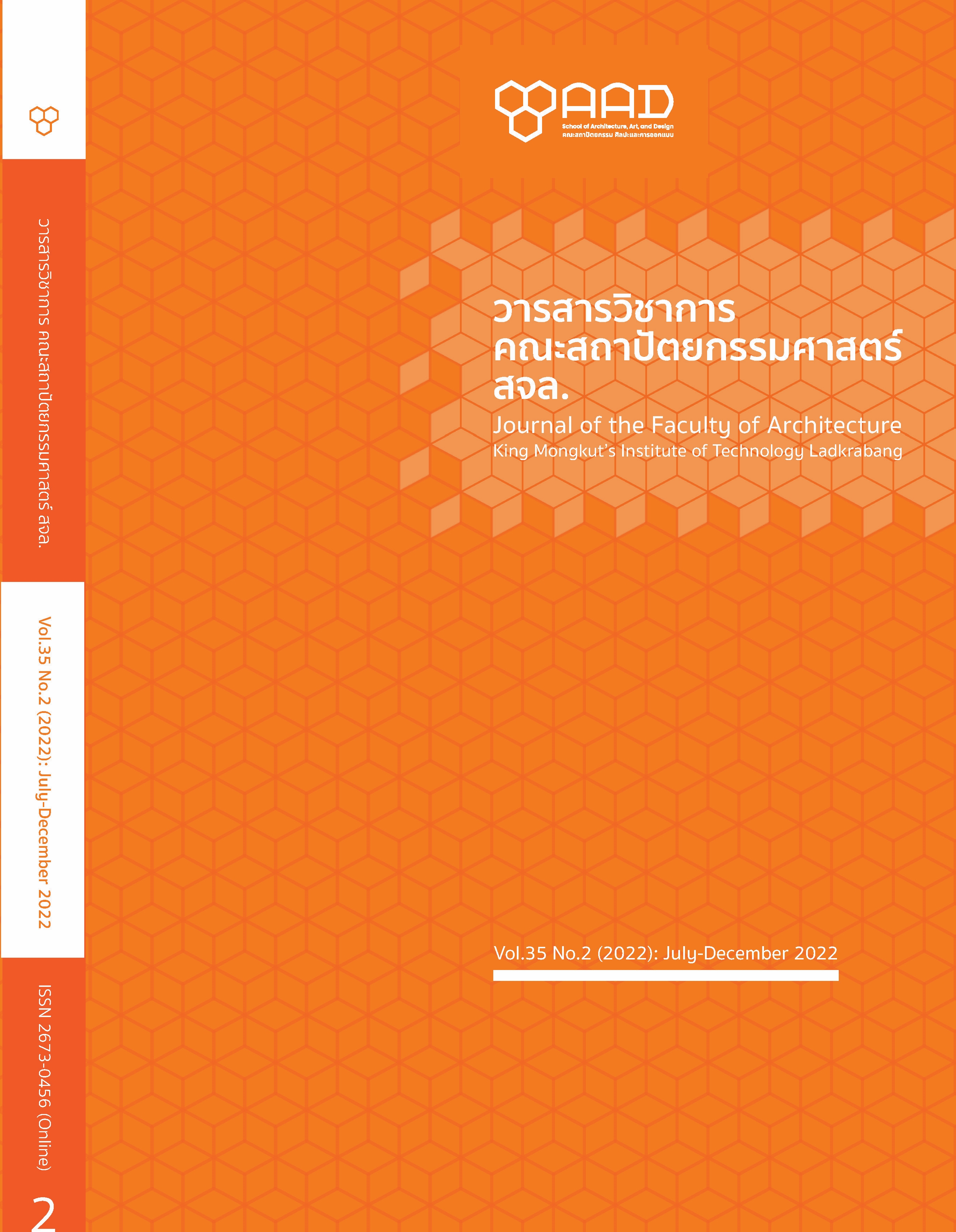Factors Contributing to Existence of the old shophouses in Chinese community, Ratchadamnoen Road, Nakhon Si Thammarat
Main Article Content
Abstract
This research questioned what factors are affected to existence in the change of old shophouses in historic towns. The objective emphasized to explain coexistence and transformation of the old shophouses as the vernacular architecture that represented the way of life in the old community of Nakhon Si Thammarat as a historical trading port among the city's economic growth, the changes of transport routes, and the modernization together with government policies to promote historical urbanization that affected the existence of shophouses.
The study consisted of the living way, the identity of the shophouses, and the factors of change to affect the coexistence of the vernacular architecture under the viewpoint of vernacular architecture as cultural life, focused the old shophouses of Chinese community on Ratchadamnoen Road, which is the core of the city and has history, socio-culture, and the development that overlapped the physical community in many eras.
Methodologically, this research used qualitative study and field survey methods such as photography, mapping, in-depth interviews, and architectural surveys. The six shophouses were selected from 1) the reflected of this traditional community and culture, and 2) those aged more than 50 years, for comparative study. Data were derived from documentary sources; historical data, policy, economy, socio-cultural changes, and shophouses of the southern Thai region.
The results pointed out that the existence of shophouses in their everyday lives through kinship and awareness of the old Chinese community was called "Tha Wang." The impacted change is 1) the transportation route change. The car parking is essential for trade. 2) Modern life is altering local life. The factors determine the use of shophouses. Today, they use a shophouse as only a shop, but in the past, they used it to live (as a house with a shop). The characteristics of the old shophouses were found three types: 1) half-timbered and mortar shophouses, 2) Sino-European shophouses, and 3) modern Chinese shophouses. This old shophouses are often not adorned but focus on functional activities rather than appearance.
Article Details

This work is licensed under a Creative Commons Attribution-NonCommercial-NoDerivatives 4.0 International License.
This work is licensed under a Creative Commons Attribution-NonCommercial-ShareAlike 4.0 International License.
Copyright Transfer Statement
The copyright of this article is transferred to Journal of The Faculty of Architecture King Mongkut's Institute of Technology Ladkrabang with effect if and when the article is accepted for publication. The copyright transfer covers the exclusive right to reproduce and distribute the article, including reprints, translations, photographic reproductions, electronic form (offline, online) or any other reproductions of similar nature.
The author warrants that this contribution is original and that he/she has full power to make this grant. The author signs for and accepts responsibility for releasing this material on behalf of any and all co-authors.
References
กัณฐิกา กล่อมสุวรรณ. (2552). การเปลี่ยนแปลงทางเศรษฐกิจของจังหวัดนครศรีธรรมราช พ.ศ. 2439-2475. (วิทยานิพนธ์ศิลปศาสตรมหาบัณฑิต, มหาวิทยาลัยเกษตรศาสตร์).
คณะสถาปัตยกรรมศาสตร์ มหาวิทยาลัยศิลปากร เสนอต่อ สำนักงานนโยบายและแผนสิ่งแวดล้อม กระทรวงวิทยาศาสตร์ เทคโนโลยีและสิ่งแวดล้อม. (2539). โครงการจัดทำแผนการจัดการอนุรักษ์และปรับปรุงสภาพแวดล้อมเมืองเก่า นครศรีธรรมราช. กรุงเทพฯ: มหาวิทยาลัย.
ไชยรัตน์ เจริญสินโอฬาร. (2549). วาทกรรมการพัฒนา: อำนาจ ความรู้ ความจริง เอกลักษณ์ และความเป็นอื่น. พิมพ์ครั้งที่ 4. กรุงเทพฯ: สำนักพิมพ์วิภาษา.
ดรุณี แก้วม่วง, นิธิ เอียวศรีวงศ์, สุธิวงศ์ พงศ์ไพบูลย์, เคี่ยม สังสิทธิเสถียร และดิลก วุฒิพาณิขย์. (2542). จีน: ผู้คนและวัฒนธรรมในภาคใต้. สารานุกรมวัฒนธรรมไทยภาคใต้. เล่ม 4. กรุงเทพฯ: มูลนิธิสารานุกรมวัฒนธรรมไทย ธนาคารไทยพาณิชย์.
ณัฏฐนิช จำรูญโรจน์ และกฤตพร ห้าวเจริญ. (2559). ปัจจัยที่ส่งผลต่อการเปลี่ยนแปลงของย่านท่าวัง จังหวัดนครศรีธรรมราช. วารสารวิชาการคณะสถาปัตยกรรมศาสตร์ สจล. 23(2), 73-89.
ปัทม์ วงศ์ประดิษฐ์ และเกรียงไกร เกิดศิริ. (2561). ปัญญาสรรค์สร้างห้องแถวการค้า จังหวัดตรัง. JARS. 15(2), 71-89.
ปูรณ์ ขวัญสุวรรณ. (2561). มรดกแห่งชีวิตประจำวันในย่านที่หลากหลายของเมืองประวัติศาสตร์นครศรีธรรมราช. สารอาศรมวัฒนธรรมวลัยลักษณ์ มหาวิทยาลัยวลัยลักษณ์ ฉบับพิเศษ สถาปัตยกรรมและการออกแบบ. 18(1), 1-24.
ไพบูลย์ ดวงจันทร์. (2542). สถาปัตยกรรมจีน: เมืองสงขลา. สารานุกรมวัฒนธรรมภาคใต้. เล่ม 16. กรุงเทพฯ: มูลนิธิสารานุกรมวัฒนธรรมไทย ธนาคารไทยพาณิชย์.
เมืองคอนดอทคอม. (2563). ภาพแปะฟ้า”เมืองคอนช่วงสี่แยกท่าวัง(ปัจจุบัน)ถึงคลองท่าวัง(ในอดีต)”. เข้าถึงได้จาก: https://www.gotonakhon.com/?p=6889.
สถาบันอาศรมศิลป์. (2562). รายงานฉบับสมบูรณ์ โครงการจัดทำแผนแม่บทและผังแม่บทการอนุรักษ์และพัฒนาบริเวณเมืองเก่านครศรีธรรมราชเสนอจังหวัดนครศรีธรรมราช. ม.ป.ส.
สันต์ สุวัจฉราภินันท์ และวันฉัตร ด่านหงส์มังกร. (2562). การสังเคราะห์ความเชื่อมโยงทางทฤษฎีของตัวตน พื้นที่ และชีวิตประจำวัน. เจ-ดี: วารสารวิชาการ การออกแบบสภาพแวดล้อม. 6(2), 21-35.
สุภาวดี เชื้อพราหมณ์. (2546). ตึกแถว ผลผลิตทางกายภาพและวัฒนธรรมในชุมชนเมืองเก่า จังหวัดสงขลา. (วิทยานิพนธ์สถาปัตยกรรมศาสตรมหาบัณฑิต, มหาวิทยาลัยศิลปากร).
อนิตา ตันเองชวน. (2557). การสำรวจและประเมินอาคารตึกแถวเก่าในย่านประวัติศาสตร์ชุมชนท่าวัง จังหวัดนครศรีธรรมราช. (วิทยานิพนธ์สถาปัตยกรรมศาสตรมหาบัณฑิต, มหาวิทยาลัยธรรมศาสตร์).
อุดม หนูทอง และมโน พิสุทธิรัตนานนท์. (2543). สถาปัตยกรรมแบบจีน-ปอร์ตุเกส (Sino-Portuguese Style) ในเขตเมืองนครศรีธรรมราช. วารสารมหาวิทยาลัยวลัยลักษณ์. 1(1), 85-114.
อดิศร ศรีเสาวนันท์ และวีระ อินพันทัง. (2559). แนวความคิดเรื่องสถานที่ และปรากฎการณ์วิทยา กับการศึกษางานสถาปัตยกรรมพื้นถิ่น. วารสารวิชาการ คณะสถาปัตยกรรมศาสตร์ มหาวิทยาลัยขอนแก่น. 16(1), 1-20.
Norberg-Schulz, C. (1971). Existence, space & architecture. New York: Praeger.
Lefebvre, H. (1991a). Critical of everydaylife: the one-volumn edition. London, New York: Verso.
Lefebvre, H. (1991b). The production of space. Oxford: Wiley-Blackwell.
Steward, J. H. (1979). Theory of culture change: the methodology of multilinear evolution. 4th ed. Urbana: University of Illinois Press.
Urban Redevelopment Authority (URA). (2021). The Shophouse. Retrieve form: https://www.ura.gov.sg/Corporate/Get-Involved/Conserve-Built-Heritage/Explore-Our-Built-Heritage/The-Shophouse.


